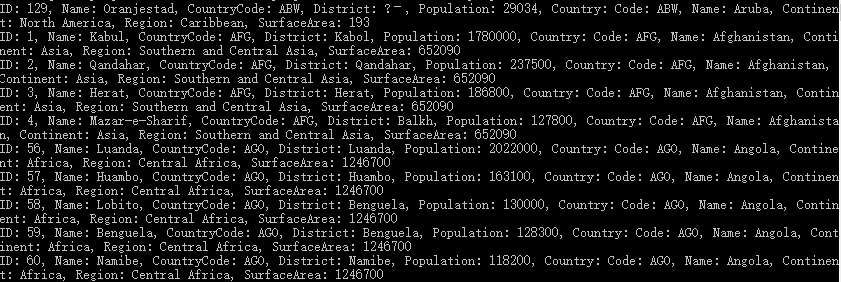Dapper作為.NET生態中廣為人知的輕量級ORM類庫在.NET Core里仍能被有效利用,並且其不但可以連通SQL Server資料庫還提供對其它資料庫,比如MySQL的支持。這裡試驗了一下通過Dapper連接MySQL的方法。 MySQL 可以選擇直接安裝在原生系統中或是Docker里。 "O ...
Dapper作為.NET生態中廣為人知的輕量級ORM類庫在.NET Core里仍能被有效利用,並且其不但可以連通SQL Server資料庫還提供對其它資料庫,比如MySQL的支持。這裡試驗了一下通過Dapper連接MySQL的方法。
MySQL
可以選擇直接安裝在原生系統中或是Docker里。
Official
Docker
Table
在MySQL中建立兩張表。
city表:
CREATE TABLE `city` (
`ID` int(11) NOT NULL AUTO_INCREMENT,
`Name` char(35) NOT NULL DEFAULT '',
`CountryCode` char(3) NOT NULL DEFAULT '',
`District` char(20) NOT NULL DEFAULT '',
`Population` int(11) NOT NULL DEFAULT '0',
PRIMARY KEY (`ID`),
KEY `CountryCode` (`CountryCode`),
CONSTRAINT `city_ibfk_1` FOREIGN KEY (`CountryCode`) REFERENCES `country` (`code`)
) ENGINE=InnoDB AUTO_INCREMENT=4080 DEFAULT CHARSET=latin1country表:
CREATE TABLE `country` (
`Code` char(3) NOT NULL DEFAULT '',
`Name` char(52) NOT NULL DEFAULT '',
`Continent` enum('Asia','Europe','North America','Africa','Oceania','Antarctica','South America') NOT NULL DEFAULT 'Asia',
`Region` char(26) NOT NULL DEFAULT '',
`SurfaceArea` float(10,2) NOT NULL DEFAULT '0.00',
`IndepYear` smallint(6) DEFAULT NULL,
`Population` int(11) NOT NULL DEFAULT '0',
`LifeExpectancy` float(3,1) DEFAULT NULL,
`GNP` float(10,2) DEFAULT NULL,
`GNPOld` float(10,2) DEFAULT NULL,
`LocalName` char(45) NOT NULL DEFAULT '',
`GovernmentForm` char(45) NOT NULL DEFAULT '',
`HeadOfState` char(60) DEFAULT NULL,
`Capital` int(11) DEFAULT NULL,
`Code2` char(2) NOT NULL DEFAULT '',
PRIMARY KEY (`Code`)
) ENGINE=InnoDB DEFAULT CHARSET=latin1Package
應用程式工程中需要添加Dapper以及Mysql.Data類庫。
dotnet add package Dapper
dotnet add package MySql.Data
Entity
編寫兩個實體類,用於映射city與country表。
public class CityEntity
{
public int ID { get; set; }
public string Name { get; set; }
public string CountryCode { get; set; }
public string District { get; set; }
public int Population { get; set; }
public CountryEntity Country { get; set; }
public override string ToString()
{
return $"ID: {ID}, Name: {Name}, CountryCode: {CountryCode}, District: {District}, Population: {Population}, Country: {Country}";
}
}public class CountryEntity
{
public string Code { get; set; }
public string Name { get; set; }
public string Continent { get; set; }
public string Region { get; set; }
public decimal SurfaceArea { get; set; }
public int IndepYear { get; set; }
public int Population { get; set; }
public decimal LifeExpectancy { get; set; }
public decimal GNP { get; set; }
public decimal GNPOld { get; set; }
public string LocalName { get; set; }
public string GovernmentForm { get; set; }
public string HeadOfState { get; set; }
public int Capital { get; set; }
public string Code2 { get; set; }
public override string ToString()
{
return $"Code: {Code}, Name: {Name}, Continent: {Continent}, Region: {Region}, SurfaceArea: {SurfaceArea} ";
}
}Repository
倉庫類中新加獲取10個城市數據的方法。這裡Dapper的Query方法有三個參數,第一個是需要執行的SQL語句,第二個是對象之間的對應關係(這個例子中city與country為一對一關係),並確定最終返回的對象類型,最後的SplitOn參數會告訴Dapper在結果集中兩張表之間以哪個欄位進行分界。
public class CityRepository
{
public List<CityEntity> Get10Cities()
{
List<CityEntity> result;
using (var conn = new MySqlConnection("Host=localhost;Port=3306;Database=world;Uid=admin;pwd=admin"))
{
var sql = "SELECT * FROM city INNER JOIN country ON city.CountryCode = country.Code LIMIT 10";
result = conn.Query<CityEntity, CountryEntity, CityEntity>(sql,
(city, country) => { city.Country = country; return city; }, splitOn: "Code").ToList();
}
return result;
}
}Test
static void Main(string[] args)
{
var repository = new CityRepository();
var cities = repository.Get10Cities();
cities.ForEach(e=>{
System.Console.WriteLine(e);
});
}程式運行的結果如下,可以看到成功藉助Dapper的力量從MySQL資料庫里獲取了所需的數據。




